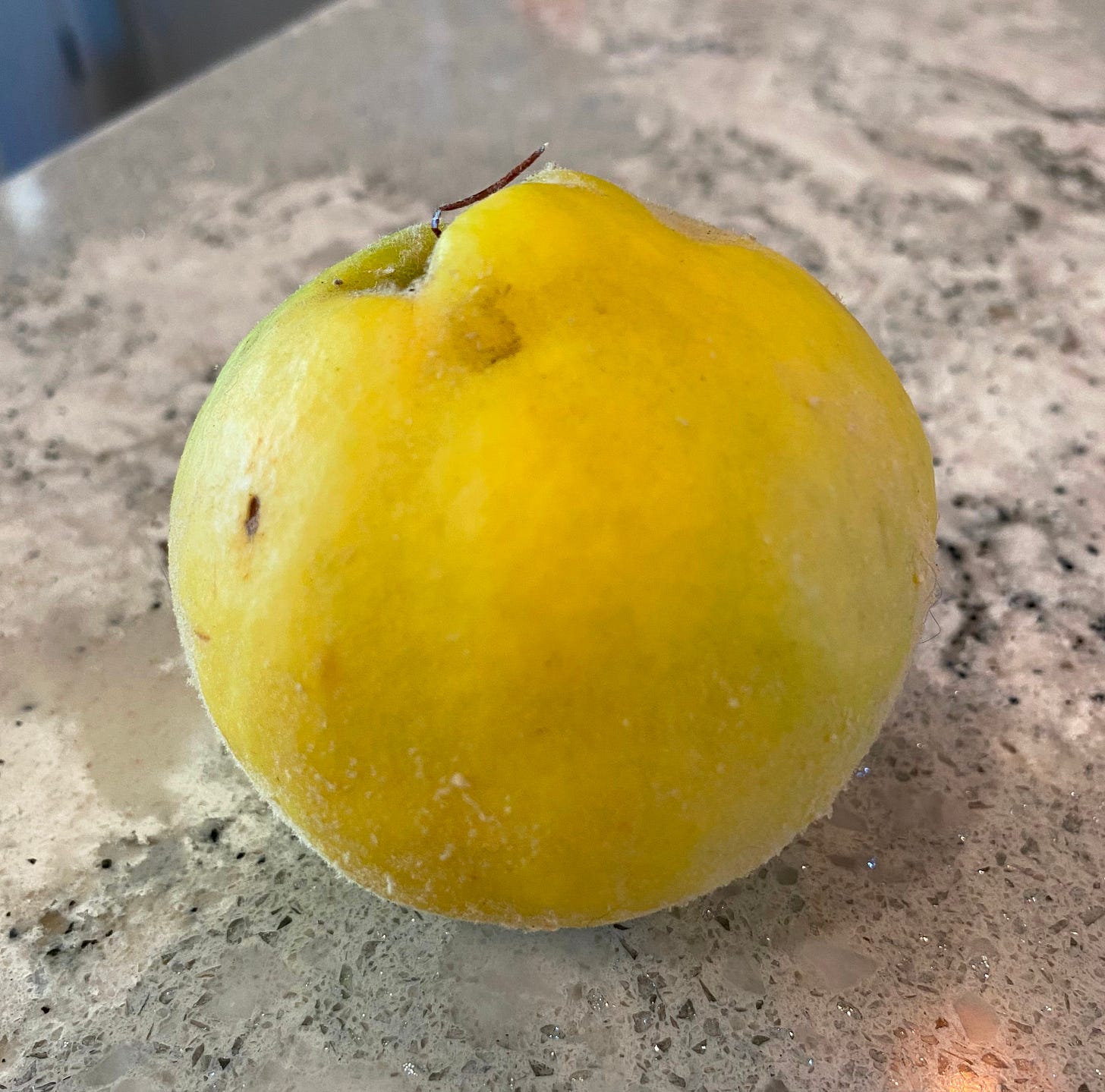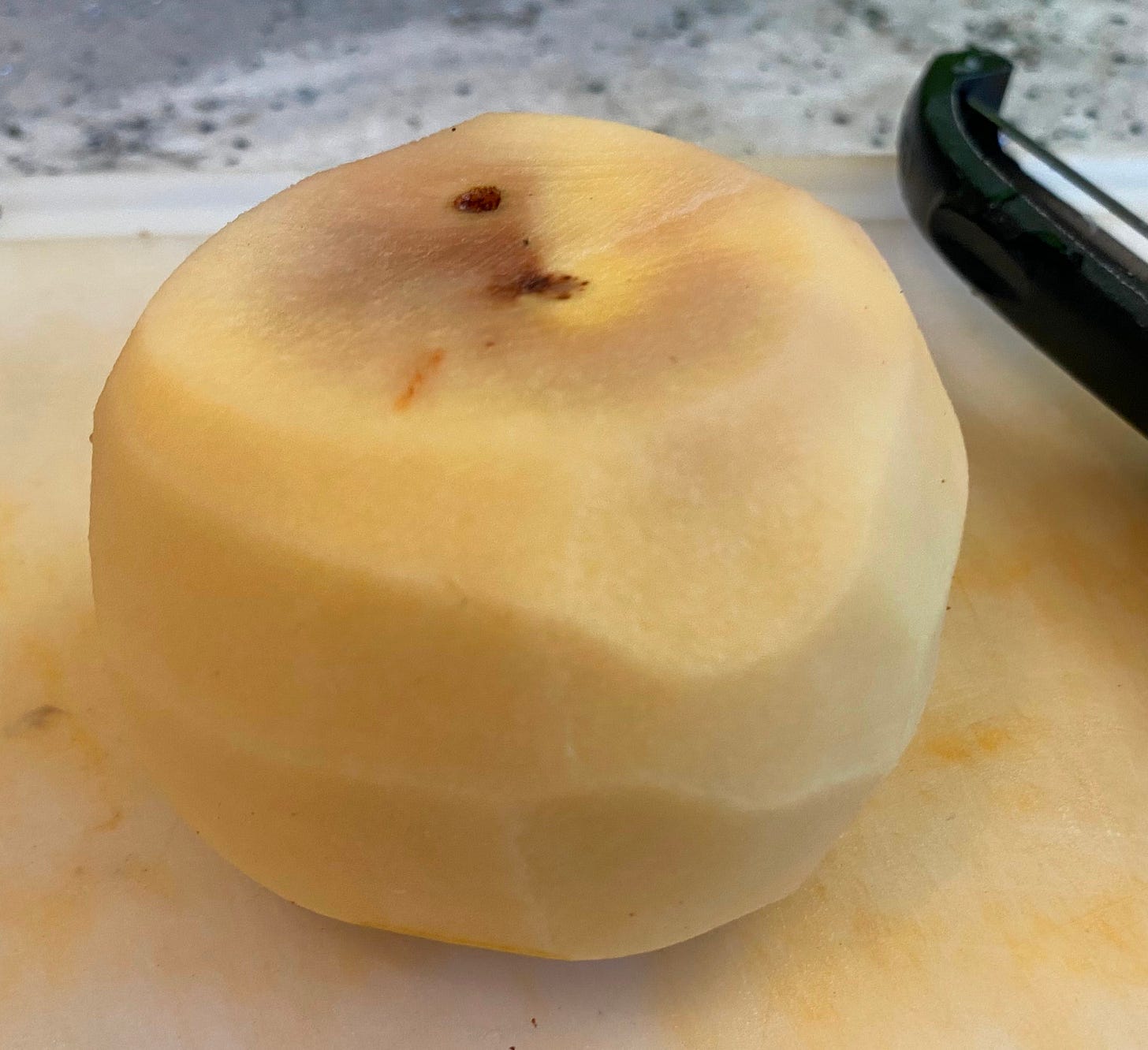Quince?
The fuzzy, floral, & fussy fruit
I consider myself pretty familiar with most types of produce. I can tell the difference between different types of kale. I love trying unusual fruits (kiwi berries were a hit). And my mind was blown when I discovered life beyond the button mushroom.
But quince? Didn’t ring a bell right away.
Oh, wait, I vaguely remembered a friend telling me I just had to try quince paste with crackers and cheese when we visited a cheese shop not far from where I live.
The jar of quince paste was a deep ruby red1. And very expensive.
It was delicious on artisan crackers with goat cheese, providing a mostly sweet, slightly tangy flavor that contrasted with the creamy saltiness of the cheese.
But I haven’t splurged on it since… until now.
I have continued to harvest with my local extrafood.org “glean team,” picking excess produce from yards and farms to be donated to local food pantries.
As the apple harvesting season ended, we moved on to picking quince and persimmons. At first, we were concerned that there wouldn’t be a demand for quince. We were wrong. Turns out that dulce de membrillo is a popular treat in Latino communities, and the first quince harvest was gone in no time.
This past weekend, we returned for more. Six huge trees, two harvesters, two and a half hours, and a few extra boxes and hands later, we harvested 676 pounds of quince, most of which has already been given away.
So what is quince?
Quince is an unassuming yellow fruit that looks like a cross between an apple and a squat pear. It has a soft white fuzz covering a waxy skin. Spend time harvesting quince and you will start to notice a sweet fragrance — like honey and flowers. A scent that lasts for weeks as raw quince patiently waits to be consumed.
Quince is rarely eaten raw or unsweetened because it is incredibly hard, sour, and astringent, making it a bit of a high-maintenance fruit.
For those who take the effort, however, the pale fruit transforms into a bold burgundy beauty the longer it is cooked.
Thanks to its high pectin content, quince is excellent for making jams, jellies, and other sweet desserts.
After some research, I found a simple way to wash and partially cook quince before attempting to cut or peel it (to avoid any sharp knife-induced injuries). It worked like a charm:
I tried a nibble of the cooked and peeled quince. It wasn’t great. It had the texture of a mealy pear and a bland, bitter, and slightly sweet flavor.
I was reluctant to dive into the traditional recipes that call for buckets of sugar (because, you know, I’m me). Yet I was pleased to find out that an easy way to introduce and experiment with quince is to add it to apple-based recipes, such as pies, crisps, crumbles, and applesauce.
I am all too familiar with homemade applesauce, so I made a batch with approximately one-quarter quince and three-quarters diced apples.2
The mix of apples I used was so sweet and flavorful that no sweetener was needed. I added a little cinnamon before mashing it to my desired chunky consistency, and it was pretty good. My husband liked it too, though we could notice a small, difficult-to-describe difference in the flavor. Overall, it was a successful first experiment.
In full disclosure, I intended to experiment more with quince before publishing this piece. But the days seem to be passing by extra quickly this year, so I decided to publish it in progress.
I look forward to connecting with my friend, who is a home baker and canner extraordinaire, to tackle a traditional Dulce de Membrillo (Quince Paste) recipe. I also have my eye on an Olive Oil Quince Cake, since I’ve also been helping friends harvest olives, which will be pressed into olive oil.
If you are curious to experiment with quince, they may be hard to find. I’d start with farmers’ markets and specialty stores. I’ll keep an eye out to see if I see them. Please do the same and let us know!
Thanks for being here,
~Allison
Inspired by this recipe, though I cooked and peeled the quince first to make cutting easier and safer




